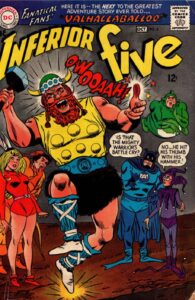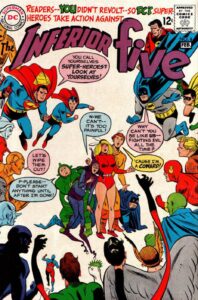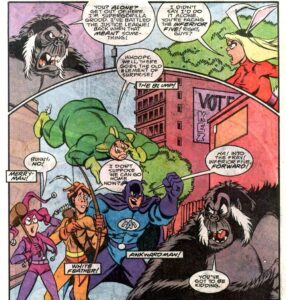The Short but Brilliant Life of the Inferior Five
by Will Morgan 01-Feb-21
Originally intended as a simple Fantastic Four parody, the Inferior Five transcended their genesis to become a witty and warm-hearted satire with a soul.
 – “You wouldn’t hit a woman with a baby, would you?”
– “You wouldn’t hit a woman with a baby, would you?”
– “No… … I’d hit her with a grown man!”
Despite a short shelf-life, and sundry revivals and “updatings” ranging from mediocre to disastrous, the original series of DC’s Inferior Five remains fondly-remembered by a certain generation of comics readers, their throwaway origins notwithstanding.
 In early 1966 E. Nelson Bridwell, one of the first fans-turned pro in comics, was asked to produce a parody of Marvel’s Fantastic Four for an issue of Showcase. Rather than produce a simple satire with look-alike versions of the FF, ENB expanded the concept, adding a fifth member, and the genius touch of making the team what are now called ‘legacy’ heroes—the grown offspring of the Freedom Brigade, legendary (in the sense that they were entirely made up for the series) super-heroes of the Golden Age.
In early 1966 E. Nelson Bridwell, one of the first fans-turned pro in comics, was asked to produce a parody of Marvel’s Fantastic Four for an issue of Showcase. Rather than produce a simple satire with look-alike versions of the FF, ENB expanded the concept, adding a fifth member, and the genius touch of making the team what are now called ‘legacy’ heroes—the grown offspring of the Freedom Brigade, legendary (in the sense that they were entirely made up for the series) super-heroes of the Golden Age.
Our “heroes”, for want of a better word, were:
—Merryman, son of Lady Liberty and the Patriot, saddled with a heroic tradition on both sides of the family dating back at least a century. Although highly intelligent and intensively trained in unarmed combat, Myron Victor’s Walter-the-Softy physique made all his training ineffective.
—Dumb Bunny, daughter of Princess Power; inheritor of her mother’s incredible strength, Athena Tremor was utterly bereft of the wisdom of her namesake goddess.
—The Blimp, son of Captain Swift, had the paternal power of flight, but was no super-speedster, easily outpaced by enemies at a slow walk.
—Awkwardman, amphibious son of Mr Might and the Mermaid; his incredible strength and ability to breathe under water were bequests from his parents, but—perhaps because of his hybrid nature—his calamitous clumsiness was all his own.
—And the White Feather, son of the Bowman, whose archery skills were every bit as great as his father’s, but whose shaking hands, owing to his incredible cowardice, negated his marksmanship.
 Though none of them would have entered the super-heroic profession by choice, they weren’t given any; their parents’ expectations trapped them in a world for which they were ill-equipped, and they caved in to parental pressure rather than forge their own paths. Their first outing was against Doctor Gregory Gruesome, a mad scientist only slightly more exaggerated than Luthor and company, whose delighted exclamation “A chance to shoot a woman—in the back! What villain could resist?” set the tone for the series, a charming combination of slapstick, whimsy, and a loving excoriation of super-hero clichés.
Though none of them would have entered the super-heroic profession by choice, they weren’t given any; their parents’ expectations trapped them in a world for which they were ill-equipped, and they caved in to parental pressure rather than forge their own paths. Their first outing was against Doctor Gregory Gruesome, a mad scientist only slightly more exaggerated than Luthor and company, whose delighted exclamation “A chance to shoot a woman—in the back! What villain could resist?” set the tone for the series, a charming combination of slapstick, whimsy, and a loving excoriation of super-hero clichés.
With the artistic aid of Joe Orlando (in Showcase #62 & 63) and Mike Sekowsky (Showcase #65, Inferior Five #1-6), E. Nelson Bridwell demonstrated his encyclopaedic knowledge of the entire heroic mythos. In a handful of issues, ENB gleefully skewered the Avengers, the X-Men, the Fantastic Four (See? He got there eventually…), Giant-Man and the Wasp, the Hulk, the T.H.U.N.D.E.R Agents, the Man From U.N.C.L.E., Tarzan of the Apes, the Green Hornet and Kato, the Scarlet Pimpernel, and more.
The high spot was issue #4, his take on Thor and the gods of Asgard. Despite its comedic nature, this story proffered, as critic Kathleen Glancy observed: “More authentic Norse mythology in a single issue than the entire run of Lee and Kirby’s Thor.”
 It all went a bit pear-shaped with issue #6, though. In what, in retrospect, was an attempt to “Marvel Bullpen” the DC staff, the issue was a satirical look at the DC offices, alienating the readership at a stroke by cracking a plethora of in-jokes about people the reader knew little of and cared less. My ten-year old self was bitterly disappointed when not only did the multitude of cover-featured guest-stars fail to appear inside, but the heroes themselves graced only a handful of panels. Decades later, my heart remains a seething ball of resentment towards #6!
It all went a bit pear-shaped with issue #6, though. In what, in retrospect, was an attempt to “Marvel Bullpen” the DC staff, the issue was a satirical look at the DC offices, alienating the readership at a stroke by cracking a plethora of in-jokes about people the reader knew little of and cared less. My ten-year old self was bitterly disappointed when not only did the multitude of cover-featured guest-stars fail to appear inside, but the heroes themselves graced only a handful of panels. Decades later, my heart remains a seething ball of resentment towards #6!
With #7, there was a definite change in tone. Win Mortimer took over the art—his amiable cartooniness suiting the light-hearted theme—but while the stories remained credited to Bridwell, either they were being ghost-written (as some critics, including Mark Evanier, aver), or he had been instructed to dumb it down, with more slapstick and throwaway gags, and no references to panelological or literary history. The parodies were still in play—Iron Pants, Cobweb Kid—but they were obvious and dismissive, with no-one’s heart seemingly in it. Other than #9, a delightful “Night at the Museum” issue which was pure comedy rather than satire, the later issues of the Five were thin fare compared to previous stellar efforts.
And with #10, the series was done. A two-issue reprint revival in the early 1970s was all we saw of the Five, apart from cameos in various crossover events, until the second series of Angel & the Ape in 1991.
 This revival of another ENB creation was helmed by Phil Foglio, famous for the cheerful and witty porno comic Xxxenophile. Fogio linked the Inferior 5 and Angel & the Ape by establishing their respective heroines, Dumb Bunny and Angel O’Day, as half-sisters, and with Bunny a supporting character in the series, the rest of the Five inevitably turned up, playing a major part in the conclusion. Foglio reputedly wanted to follow up with an Inferior Five mini, but Angel & the Ape’s sales, alas, didn’t justify it.
This revival of another ENB creation was helmed by Phil Foglio, famous for the cheerful and witty porno comic Xxxenophile. Fogio linked the Inferior 5 and Angel & the Ape by establishing their respective heroines, Dumb Bunny and Angel O’Day, as half-sisters, and with Bunny a supporting character in the series, the rest of the Five inevitably turned up, playing a major part in the conclusion. Foglio reputedly wanted to follow up with an Inferior Five mini, but Angel & the Ape’s sales, alas, didn’t justify it.
 The Five’s last hurrah, shockingly enough, was in the morass of… (shudder) modern comics. In the final issue of the early 2000’s Brave & Bold, #35, the 30th century’s Legion of Substitute Heroes, in an attempt to get some publicity, venture back to the past to pick up the Doom Patrol and save Earth from destruction. Owing to a series of unfortunate events, the Subs end up with the Inferior Five instead, and the Five’s eternal dumb luck, plus Dumb Bunny’s intellect (!) saves the day. J. Michael Straczynski and Jesus Saiz, to everyone’s astonishment, “got” the Five. Who’d have thought?
The Five’s last hurrah, shockingly enough, was in the morass of… (shudder) modern comics. In the final issue of the early 2000’s Brave & Bold, #35, the 30th century’s Legion of Substitute Heroes, in an attempt to get some publicity, venture back to the past to pick up the Doom Patrol and save Earth from destruction. Owing to a series of unfortunate events, the Subs end up with the Inferior Five instead, and the Five’s eternal dumb luck, plus Dumb Bunny’s intellect (!) saves the day. J. Michael Straczynski and Jesus Saiz, to everyone’s astonishment, “got” the Five. Who’d have thought?
There have been other appearances by the Inferior Five, but none worth dignifying with inclusion here—either they were fleeting cameos, or reboots or retrofits, missing the point and the appeal of the team entirely.
What made the Five distinctive? The quality of the creators, sure. The witty comedy, absolutely. But the keynote of the Five’s appeal was their paradoxical courage in the face of all obstacles. They, more than anyone else, were painfully aware of their inadequacies, but they pulled on their big-boy pants and went out to fight the forces of evil anyway, despite the looming spectre of almost certain defeat. They pooled their meagre talents and achieved something greater than themselves. The lack of self-awareness in the later issues, when the Five seemed to be ignorant of their own drawbacks, may be where the strip lost its heart, and consequently its uniqueness. But when the strip is at its peak, it remains a little gem, a parody with a soul.
Recommended Issues:
Showcase (1956) #62, 63, 65; Inferior Five (1967) #1-5, 9; Angel & the Ape (1991) #1-4; Brave & Bold (2007) #35.
Tags: Angel and the Ape, Awkwardman, Blimp, Brave and the Bold, Dumb Bunny, E. Nelson Bridwell, Freedom Brigade, Inferior Five, J. Michael Straczynski, Jesus Saiz, Joe orlando, Legion of Substitute Heroes, Merryman, Mike Sekowsky, Phil Foglio, Thor, White Feather, Win Mortimer, Xxxenophile